
Cycloaddition Reactions in Organic Synthesis
.pdf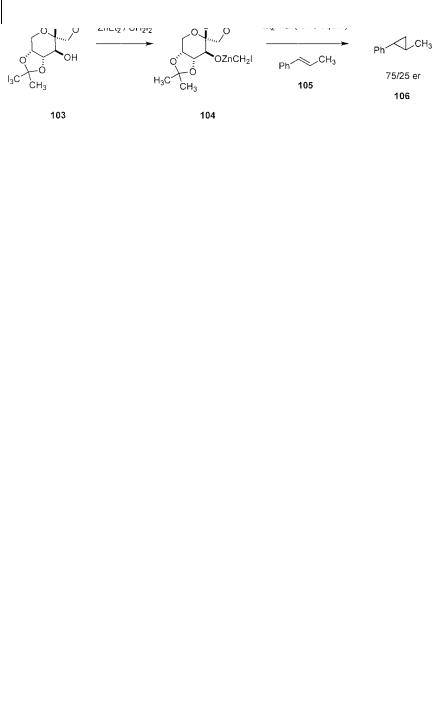
118 3 Enantioselective [2+1] Cycloaddition: Cyclopropanation with Zinc Carbenoids
Scheme 3.30
sult in formation of a carbenoid with high reactivity. A possible explanation for this phenomenon is that, once formed, the iodomethylzinc alkoxide has an attenuated Lewis acidity, because of electron donation from the lone pairs of the oxygen. If the electron density at the zinc center increases too drastically, the methylene transfer process is inhibited. This feature explains:
(i)why strong Lewis bases interfere with the reactivity of the zinc carbenoid;
(ii)why 28 is not an active cyclopropanating agent (Fig. 3.3); and
(iii)why such long reaction times are required with Fujisawa’s tartrate modified reagent (Table 3.6).
These results are in agreement with Charette’s findings regarding the reactivity of in-situ generated iodomethylzinc alkoxides (Scheme 3.29) [60]. The significance of this phenomenon will become important in the design of asymmetric catalysts.
3.4.3.2 Chirally Modified Substrates
The conceptual complement to the chiral modification of the catalyst is the temporary modification of the substrate. Unlike the chiral auxiliary strategy, temporary substrate modification has greater latitude in introducing the kind of groups
Fig. 3.8 Cyclopropanation of styrene in the presence of alcohol ligands. [Yang, Z.; Lorenz, J.C.; Shi, Y. Tetranedron Lett. 1998, 39, 8621. Reprinted with permission from Elsevier Ltd.]

3.4 Stereoselective Simmons-Smith Cyclopropanations 119
that can effectively control the reaction. Because they need not be covalently attached and removed, the modes of binding to the substrate are also more diverse and the directing groups need not be compatible with isolation and purification steps. The success of this approach is best illustrated by the dioxaborolane modifier 108 pioneered by Charette (Table 3.8) [66]. In this design, the dioxaborolane serves a number of roles reminiscent of the ZnI2 unit in the bimetallic complexes. The trivalent boron atom can coordinate to the hydroxyl group of a substrate alcohol while the zinc carbenoid coordinates to one of the Lewis basic sites in the tartaric acid diamide backbone. Despite the apparent complexity of the dioxaborolane, it is functionally equivalent to zinc iodide. Highly selective cyclopropanation is observed in the presence of a stoichiometric amount of the reagent in a variety of solvents, although dichloromethane proves to be best. The reaction is highly selective for both aryland alkyl-substituted allylic alcohols (Table 3.8, entries 1 and 2). Both E and Z double bond isomers yield highly selective reactions, as do trisubstituted olefins (Table 3.8, entries 3–5). Allylic alcohols containing secondary coordination sites react with high selectivity (Table 3.8, entries 6 and 7). The ethers clearly do not interfere with the selective reaction by providing an alternative site for reagent coordination, a problem that will be addressed again later in the section on asymmetric catalysis. Cyclic allylic alcohols are cyclopropanated with high selectivity as well (Table 3.8, entry 8).
This chiral modifier provides one of the only methods for selective cyclopropanation of substrates which are not simple, allylic alcohols. In contrast to the catalytic methods which will be discussed in the following section, the dioxaborolane has been shown to be effective in the cyclopropanation of a number of allylic ethers [67]. This method has also been extended to systems where the double
Tab. 3.8 Cyclopropanation of allylic alcohols with dioxaborolane 108
Entry |
Alcohol |
R1 |
R2 |
R3 |
Product |
Yield (%) |
er |
|
1 |
23 |
H |
Ph |
H |
24 |
> 98 |
97 |
: 3 |
2 |
107a |
H |
Pr |
H |
109a |
80 |
97 |
: 3 |
3 |
107b |
Et |
H |
H |
109b |
90 |
97 |
: 3 |
4 |
107c |
Me |
Me |
H |
109c |
86 |
97 |
: 3 |
5 |
107d |
H |
Ph |
Me |
109d |
96 |
93 |
: 7 |
6 |
107e |
H |
BnOCH2 |
H |
109e |
87 |
97 |
: 3 |
7 |
107f |
BnOCH2 |
H |
H |
109f |
93 |
96 |
: 4 |
8 |
107g |
H |
–(CH2)4– |
109g |
84 |
80 |
: 20 |
|
|
|
|
|
|
|
|
|
|
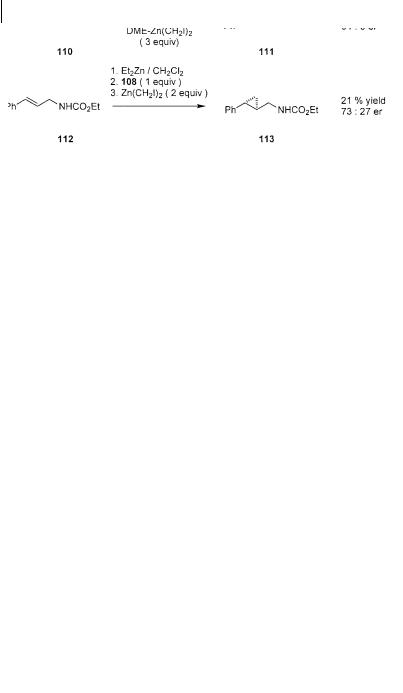
120 3 Enantioselective [2+1] Cycloaddition: Cyclopropanation with Zinc Carbenoids
Scheme 3.31
bond is fairly remote with respect to the hydroxyl group (Scheme 3.31). Homoallylic alcohols (110) yield cyclopropane products in good yields and with high selectivities. Even allylic carbamates (112) can be cyclopropanated with moderate selectivity, albeit in only fair yields.
The stereochemical outcome of this process can be rationalized through analysis of the structure of the dioxaborolane and its interaction with the zinc carbenoid (Fig. 3.9). 1H NMR experiments reveal that CH3I is produced during the course of the reaction, indicating that the iodomethylzinc alkoxide had been formed. Coordination of the boron activates the carbenoid and allows the methylene transfer to proceed [60]. A crucial stereodirecting component comes from the additional complexation of the zinc atom to the syn facial amide oxygen which orients the zinc carbenoid for selective delivery to the alkene. The boron bound butyl group and the allylic alcohol then extend out in staggered, low energy conformations. Such an analysis leads to a correct prediction of the observed configuration of the product.
The generality of the dioxaborolane method makes it well-suited for synthesis of complex natural products. For example, Nicolaou et al. have successfully used
Fig. 3.9 Proposed transition state for cyclopropanation with dioxaborolane 108. [Charette, A.B.; Juteau, H.; Lebel, H.; Molinaro, C. J. Am. Chem. Soc. 1998, 120, 11943. Reprinted with permission from The American Chemical Society]

3.4 Stereoselective Simmons-Smith Cyclopropanations 121
this method to obtain cyclopropane containing fragments required for the synthesis of the biologically active compounds (12S,13S,15S)-cyclopropyl epithilone A [68], plakosides A and B [69].
The exploration of chirally modified reagents was another important step towards a full understanding of the Simmons-Smith cyclopropanation. It also provided two key concepts which will resurface in the discussion of catalytic methods. Considering the work of Fujisawa and Denmark, it can be seen that both their strategies involved formation of a chiral zinc species which was a surrogate for the bridging ZnI2 proposed in Rickborn’s model (v, Fig. 3.5). Attachment of chiral ligands at this position surely has an influence over the approach of the carbenoid to the enantiotopic faces of the alkene. The study of the reactivity of iodomethylzinc alkoxides provides a second concept which we be helpful in ligand design for catalytic systems. Highly Lewis basic ligands are a poor choice for any system involving a zinc carbenoid. Both of these factors will become pivotal in the forthcoming discussion.
3.4.4
Asymmetric Catalysis
3.4.4.1 General Considerations
The development of a catalytic system for cyclopropanation based on zinc carbenoids presents a number of challenges that are unique to this reagent and reaction class. Unlike many other organometallic reactions that are amenable to li- gand-accelerated catalysis [70], the Simmons-Smith reaction itself proceeds at reasonable rates in the absence of additives. It is thus distinguished from other cyclopropanation processes that employ diazo precursors which can be activated by transition metal complexes bearing chiral ligands. It is also distinguished from the addition of dialkylzinc reagents to carbonyl compounds which does not readily proceed without activation by e.g. amino alcohols [62]. Thus, the major challenge for this transformation is the discovery of a ligand system to catalyze a reaction which does not need ligands! As will be described in this section a solution to this problem was forthcoming in a fashion not unlike what was ultimately found for the dialkylzinc addition process, namely, introducing the activating and stereodirecting functions in a second entity which does not interfere with the reagent.
There are three main criteria for design of this catalytic system. First, the additive must accelerate the cyclopropanation at a rate which is significantly greater than the background. If the additive is to be used in substoichiometric quantities, then the ratio of catalyzed to uncatalyzed rates must be greater than 50 : 1 for practical levels of enantio-induction. Second, the additive must create well defined complexes which provide an effective asymmetric environment to distinguish the enantiotopic faces of the alkene. The ability to easily modulate the steric and electronic nature of the additive is an obvious prerequisite. Third, the additive must not bind the adduct or the product too strongly to interfere with turnover.
The formulation of an additive for zinc carbenoid cyclopropanation that meets these criteria is severely compromised by the by the inherent Lewis acidity of the zinc atom. This Lewis acidity is required for methylene transfer and plays a major

122 3 Enantioselective [2+1] Cycloaddition: Cyclopropanation with Zinc Carbenoids
role in the assembly of the putative bimetallic transition state assembly. As has already been noted, strongly Lewis basic ligands such as chiral bis ether 27 inhibit the cyclopropanation process. Although it is possible to substitute halogens with weak Lewis basic groups (e.g. in ICH2ZnO2CCF3) [23], it is unwise to expect that another ligand could be directly bonded to the zinc carbenoid and retain reactivity. Further, in asymmetric catalysis, highly Lewis acidic reagents are often plagued by the problem of catalyst turnover [71]. The ligand must then balance the need to associate and control the stereochemical course of the addition, but then dissociate from the product in a rapid and favorable equilibrium.
Although is it possible to delineate the requirements for a suitable catalytic system, reducing this to practice is a daunting prospect. As is the case in many examples of asymmetric catalysis, empirical survey provides the initial leads which, aided by an understanding of the process, allows for accelerated development.
3.4.4.2 Initial Discoveries
In 1992 Kobayashi et al. disclosed the first example of a catalytic, asymmetric cyclopropanation by employing a bis-sulfonamide catalyst 114 as an additive (Table 3.9) [72]. The reaction system that was developed for these catalysts involves an allylic alcohol and an unusual stoichiometric combination of diethylzinc and diiodomethane. The C2-symmetric sulfonamides are fairly weak Lewis bases due to the strong electron withdrawing nature of the sulfonamide group and thus avoid the problems associated with the use of oxygen ligands, which clearly decelerate the methylene transfer step. The reaction proceeds in good yields and selectivities with several aromatic sulfonamides (Table 3.9). In the initial survey, 4- nitrobenzenesulfonamide 114d proved to be the best ligand, but the parent benzenesulfonamide 114a was found to be comparable. Curiously, the 3-nitrobenzene- sulfonamide ligand 114c shows much lower selectivity and the results with trifluoromethylbenzenesulfonamides 114e and 114 f are equally poor. Clearly, the electronic nature of the groups on nitrogen are influential but no trend is apparent.
The stoichiometry used for formation of the zinc reagent is noteworthy. Although it is presumed that the Furukawa reagent is being formed in the reaction, the conditions clearly deviate from the original requirement of two equivalents of diiodomethane per equivalent of diethylzinc. A possible reason for this protocol may be rooted in the belief that during deprotonation of the alcohol or the sulfonamide, some the iodomethyl groups may be lost as methyl iodide. Another reason, cited in the study of chiral vinyl ethers, may involve gradual decomposition of the zinc carbenoid. However, this issue is not fully addressed here. The cyclopropanation only proceeds in non-coordinating solvents, such as CH2Cl2. Not surprisingly, basic solvents such as Et2O and THF have an inhibitory effect on the process. The hydroxyl group of cinnamyl alcohol is crucial for enantioselectivity. Whereas allylic methyl ethers react readily, they lead to racemic products. This observation has been interpreted to imply that the ether is capable of coordinative activation of the zinc carbenoid, but that it does not permit association with the chiral ligand-modified species. This hypothesis was tested by examining the cyclopropanation of a number of 2-bu-
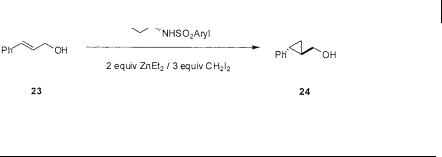
3.4 Stereoselective Simmons-Smith Cyclopropanations 123
Tab. 3.9 Kobayashi’s sulfonamide ligands 114a–f
Entry |
Catalyst |
Aryl |
Yield (%) |
er |
(24) |
|
|
|
|
|
|
1 |
114a |
C6H5 |
75 |
66 |
: 34 |
2 |
114b |
2-NO2C6H4 |
92 |
88 |
: 12 |
3 |
114c |
3-NO2C6H4 |
72 |
84 |
: 16 |
4 |
114d |
4-NO2C6H4 |
82 |
88 |
: 12 |
5 |
114e |
4-CF3C6H4 |
99 |
66 |
: 34 |
6 |
114f |
3,5-(CF3)2C6H3 |
99 |
85 |
: 15 |
|
|
|
|
|
|
tene-1,4-diol derivatives 115 and 117 (Scheme 3.32) [72 c]. If coordination with the ether oxygen is competitive with coordination to the alcohol, a product with diminished selectivity should be produced. The cyclopropanation of the mono-benzyl ether 115 proceeds with a significantly lower enantiomeric excess when compared to a simple allylic alcohols. This indicates that reaction through coordination of the reagent to the benzyl ether is competitive. By inhibiting association of the zinc carbenoid through the use of a bulky protecting group (e.g. trityl ether 117) better selectivity is observed. It is interesting to note that mono-benzyl ethers of this type can be cyclopropanated using Charette’s dioxaborolane 108 without a loss in enantioselectivity (Table 3.8).
On the basis of these observations, Kobayashi proposed transition structure xiii to account for the enantioselectivity (Fig. 3.10) [72 b]. The proposed transition structure properly incorporates elements from previous proposals concerning zinc carbenoid reactivity. By analogy to Rickborn’s proposed bimetallic transition structure v (Fig. 3.5), this model suggests the involvement of three zinc atoms. The zinc sulfonamide complex assumes the position normally occupied by ZnI2 in the achiral process. The suggestion that the true catalytic species is the zinc sulfonamide complex rather than the sulfonamide is helpful in rationalizing the activity of the catalyst. In this model, the ligand does not directly activate the reagent. Thus, inhibition of reagent activity and catalyst turnover are not problems since that zinc atom need not dissociate from the ligand. This model suggests the important role of the free hydroxyl group in binding the catalytic species. Without formation of the zinc alkoxide, the assembly loses one important point of attachment, compromising its ability to anchor the chiral zinc-sulfonamide complex.
Despite its incorporation of all the reactive components, this model leaves much to be desired. For example, the formation of the zinc alkoxide and zinc sulfonamide
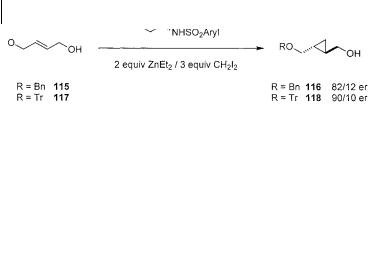
124 3 Enantioselective [2+1] Cycloaddition: Cyclopropanation with Zinc Carbenoids
Scheme 3.32
Fig. 3.10 Transition structure proposal for cyclopropanation with 114
complexes is advanced without evidence. Further, the nature of the cyclopropanating agent is not clear. Neither does this structure adequately explain the role of the chiral diamine in determining selectivity, nor the origin of accelerated cyclopropanation.
In an effort to improve upon this original system, Imai et al. undertook the investigation of a number of amino acid-derived bis sulfonamide ligands 119 in the cyclopropanation (Table 3.10) [73]. The use of these ligands provides cyclopropanes in exceptional yields while selectivities are comparable to those observed from the cyclohexane-1,2-diamine-based catalysts (114). However, an advantage of this ligand system is the opportunity for structural variation at three points, thereby increasing the diversity of available catalysts. Not only can the group attached to the stereogenic center be modified, but each of the sulfonamide groups can be independently varied to optimize selectivity (Table 3.10). Changing the substituent on the ligand backbone as in 119a–c has little effect on selectivity, unless it becomes too sterically demanding (119c). Increasing the size of this group has either a negligible or detrimental effect on selectivity. Changes in the sulfonamide groups as in 119d–f have a much stronger influence on the selectivity. Whereas a simple steric differentiation between the groups is not beneficial, an electronic differentiation provides the higher selectivity.
Although Kobayashi’s transition structure proposal xiii could be applied to these systems, the success of these unsymmetrical ligands may be indicative of a high degree of asymmetry being favored in the selective cyclopropanation. The superiority of the ligand 119e, with individual sulfonamides which are differentiated both sterically and electronically, further supports this notion. A mechanistic rationale for this observation is hard to formulate, but one possible explanation may ascribe a key role to the sulfonyl oxygens. In Kobayashi’s transition state two zinc atoms are coordinatively unsaturated. Since zinc prefers to be tetra-coordinate in this oxidation state, intramolecular coordination of one of the sulfonyl oxygens is
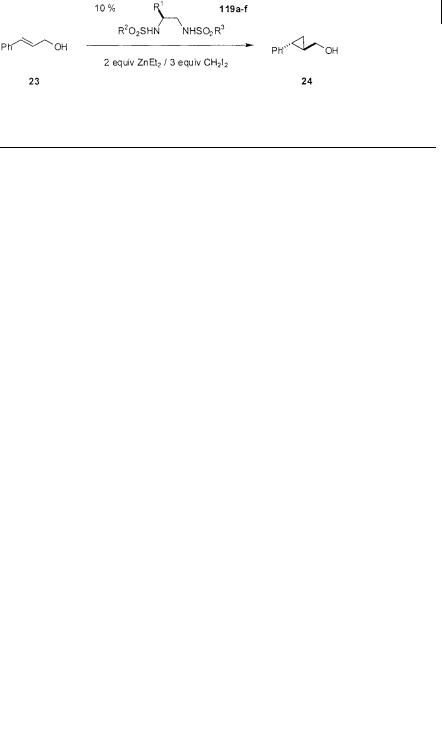
3.4 Stereoselective Simmons-Smith Cyclopropanations 125
Tab. 3.10 Cyclopropanation with sulfonamide ligands 119a–f
Entry |
Catalyst |
R1 |
R2 |
R3 |
Yield (%) |
er |
(24) |
1 |
119a |
Me |
Ph |
Me |
100 |
79 |
: 21 |
2 |
119b |
i-Pr |
Ph |
Me |
100 |
79 |
: 21 |
3 |
119c |
t-Bu |
Ph |
Me |
100 |
71 |
: 29 |
4 |
119d |
Bn |
Me |
4-CH3C6H4 |
93 |
91 |
: 9 |
5 |
119e |
Bn |
Me |
4-NO2C6H4 |
100 |
93 |
: 7 |
6 |
119f |
Bn |
Me |
2,4,6-(CH3)3C6H2 |
100 |
88 |
: 12 |
|
|
|
|
|
|
|
|
reasonable. By differentiating the two sulfonyl groups as in 119e, coordination to the relatively electron-rich oxygens of the methanesulfonyl functionality may reinforce the chiral environment provided by the diamine backbone and increase selectivity as shown in xiv (Fig. 3.11). The proximity of this electron-rich sulfonyl group to the stereocenter contained in the backbone may be of importance. The involvement of the sulfonyl oxygens in the stereochemistry determining event will later be invoked by Denmark. However, subsequent experiments cast doubt upon the importance of that interaction in their particular system (vide infra).
The success of the bis-sulfonamide unit as a ligand in creating an active zinc catalyst suggests its use with other metals in creating active complexes. Changes in the Lewis acidity of the sulfonamide-bound metal may lead to interesting changes in selectivity and reactivity. Titanium-based sulfonamide catalysts do promote the reaction, but the observed enantioselectivity is not comparable with the zinc sulfonamide [72 a]. The aluminum sulfonamide complex 120 is also effective in promoting the cyclopropanation of cinnamyl alcohol by the Kobayashi protocol (Scheme 3.33) [74]. Comparable yields and selectivities are obtained by use of the bis-benzenesulfonamide aluminum complex prepared from triisobutylaluminum
Fig. 3.11 Transition structure proposal for cyclopropanation with electronically differentiated ligands

126 3 Enantioselective [2+1] Cycloaddition: Cyclopropanation with Zinc Carbenoids
(120a). Interestingly, the use of trimethylaluminum to prepare the complex (120b) leads to slightly lower selectivities. Although it is tempting to interpret these results in terms of the steric bulk of the alkyl substituent in the transition state assembly, no evidence has been forwarded on the nature of the complexes.
Scheme 3.33
The basic motif common to these successful examples is the introduction of a chiral metal complex that can bring together the substrate (perhaps as a zinc alkoxide) and the carbenoid reagent in a chiral environment provided by the ligand. By analogy to the distinction between substrate and reagent modification found with the stoichiometric methods, so too are there two classes of catalytic methods. An approach to temporary substrate modification in asymmetric catalysis was introduced by Charette in 1995. This novel catalytic system is based on the Lewis acidic activation of the allyloxyzinc carbenoid by a chiral titanium species 121 (Scheme 3.34) [60]. Charette had previously shown that iodomethylzinc alkoxides are not capable of intramolecular methylene transfer. After screening a number of additives, it was observed that certain Lewis acids could facilitate cyclopropanation with this previously unreactive iodomethylzinc allyloxide unit. Since chiral Lewis acids are commonly used in asymmetric catalysis, application of a known, successful catalyst may provide some asymmetric induction. The titanium TADDOL complex 121 (well known to promote other asymmetric transformations [75]) is an efficient catalyst for the cyclopropanation of allylic alcohols and provides good levels of selectivity for disubstituted allylic alcohols. Still, the method requires a fairly high catalyst loading. The result with a trisubstituted allylic alcohol shows a considerably lower enantioselectivity. Although a transition state structure that rationalizes the observed selectivity is difficult to formulate, it is reasonable to conclude that the role of the Lewis acid catalyst is probably to activate the zinc carbenoid by withdrawing electron density through complexation of the oxygen, thus introducing a chiral environment around the iodomethylzinc group.
These initial reports demonstrated that a catalytic asymmetric variant of the Simmons-Smith reaction could be developed. Although good yields and selectivities were obtained, the lack of a clear understanding of the origin of activation, the limited structural information on the active species and the absence of a stereochemical model made rational improvements difficult at best. The next
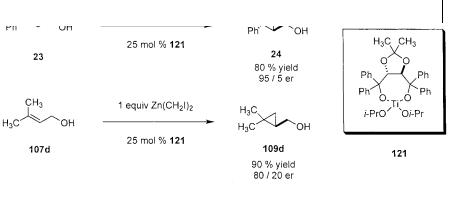
3.4 Stereoselective Simmons-Smith Cyclopropanations 127
Scheme 3.34
stage in the development of a practical and selective method involved a detailed investigation of the many experimental variables and a in depth study of the nature of the species responsible for the observed selectivity.
3.4.4.3 Defining the Role of Reaction Protocol
For a reaction as complex as catalytic enantioselective cyclopropanation with zinc carbenoids, there are many experimental variables that influence the rate, yield and selectivity of the process. From an empirical point of view, it is important to identify the optimal combination of variables that affords the best results. From a mechanistic point of view, a great deal of valuable information can be gleaned from the response of a complex reaction system to changes in, inter alia, stoichiometry, addition order, solvent, temperature etc. Each of these features provides some insight into how the reagents and substrates interact with the catalyst or even what is the true nature of the catalytic species.
As part of an independent study of catalytic asymmetric cyclopropanation, Denmark et al. described a systematic investigation of the effect of addition order, stoichiometry and catalyst structure on sulfonamide-catalyzed Simmons-Smith cyclopropanations. Although early studies had shown promising levels of enantioselectivity, higher selectivity would be required for this to be a synthetically useful transformation. The principal issues that were addressed by this study included:
(i)how the substrate allylic alcohol interacts with the catalyst;
(ii)whether the bis-sulfonamide is fully deprotonated and complexed with zinc; and
(iii)determination of the structure of the active catalytic species.
The 1,2-cyclohexanediamine-derived sulfonamide is not unique in its ability to afford enantiomerically enriched cyclopropanes. The efforts at improving the original protocol led not only to higher selectivity, but to a deeper understanding of the nature of the catalytic process.
Denmark et al. explored variations on the original reaction protocol to gain information about the role of the individual reactive components [76]. For these studies,
